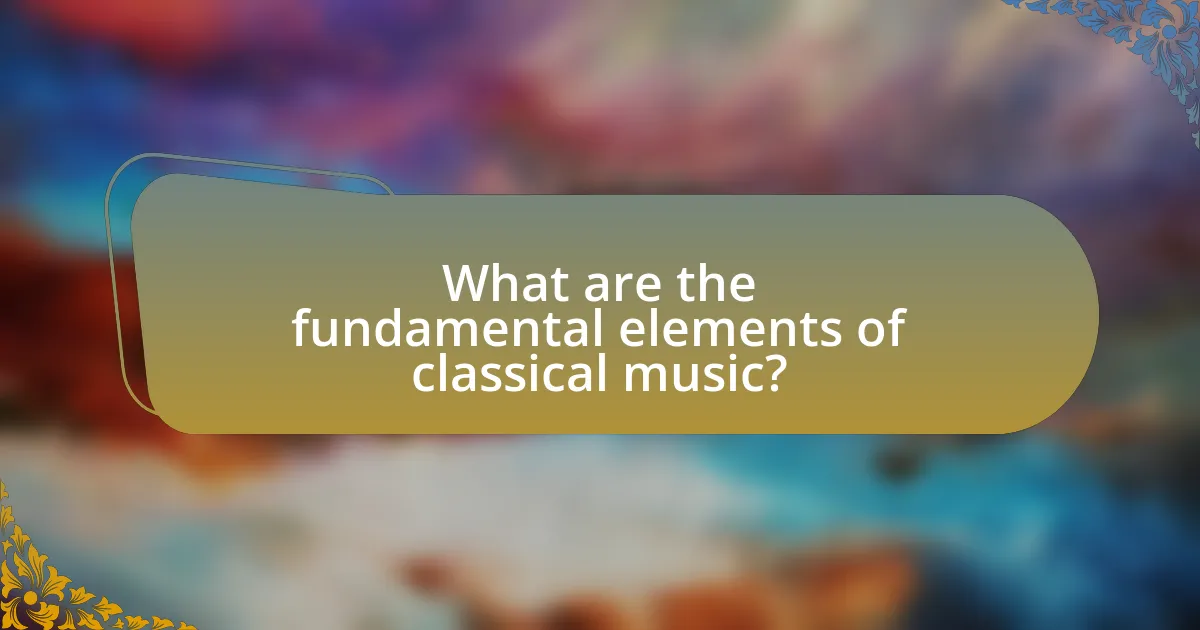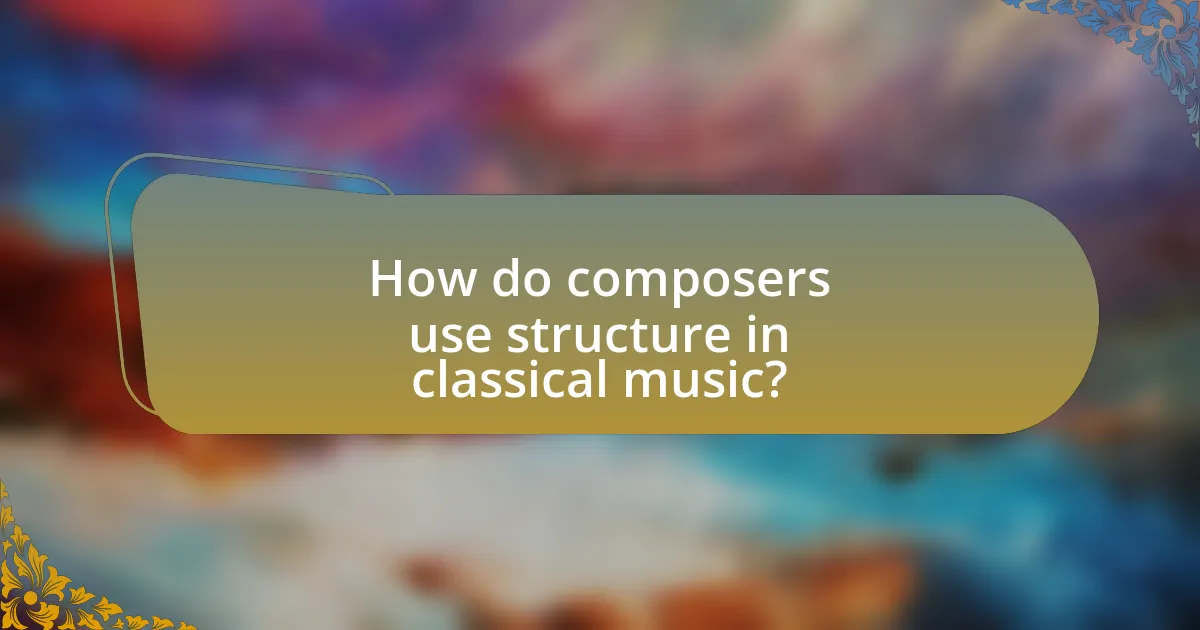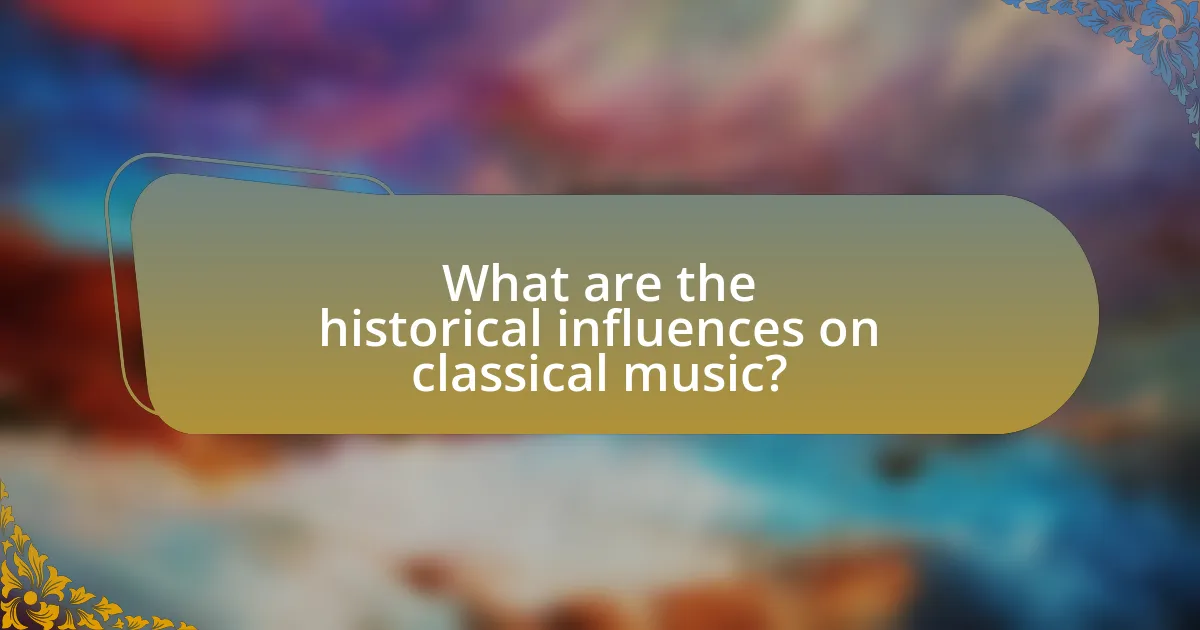The article “Understanding the Elements of Classical Music: A Beginner’s Guide” provides a comprehensive overview of the fundamental components that define classical music, including melody, harmony, rhythm, texture, form, and dynamics. It explores how these elements contribute to the emotional and structural aspects of compositions, highlighting the significance of instrumentation and the role of different musical forms. Additionally, the article examines the historical influences on classical music, the impact of cultural movements, and offers practical tips for beginners to enhance their appreciation and understanding of the genre. Through this guide, readers will gain insights into the intricate relationships between various musical elements and their contributions to the overall experience of classical music.

What are the fundamental elements of classical music?
The fundamental elements of classical music are melody, harmony, rhythm, texture, form, and dynamics. Melody refers to the sequence of notes that are perceived as a single entity, while harmony involves the combination of different musical notes played or sung simultaneously. Rhythm is the pattern of sounds and silences in music, providing the temporal structure. Texture describes how many layers of sound are heard simultaneously, and how they interact, which can range from a single melody to complex polyphony. Form refers to the overall structure or plan of a piece of music, such as sonata form or rondo. Finally, dynamics indicate the volume of music, affecting the emotional expression. These elements collectively define the character and complexity of classical music, as evidenced by the works of composers like Bach, Mozart, and Beethoven, who utilized these components to create intricate musical landscapes.
How do melody and harmony contribute to classical music?
Melody and harmony are fundamental components that shape the structure and emotional expression of classical music. Melody provides the main theme or tune, which is often memorable and serves as the focal point for listeners. Harmony, on the other hand, supports the melody by adding depth and richness through chords and intervals, creating a fuller sound.
In classical music, the interplay between melody and harmony can evoke a wide range of emotions, as seen in works by composers like Beethoven and Mozart, who skillfully used these elements to enhance the narrative and emotional impact of their compositions. For instance, Beethoven’s Symphony No. 9 features a powerful melody that is complemented by complex harmonies, resulting in a profound emotional experience. This relationship between melody and harmony is essential for establishing the overall character and mood of a piece, making them indispensable in the realm of classical music.
What is the role of melody in classical compositions?
Melody serves as a fundamental element in classical compositions, acting as the primary means of musical expression and communication. It provides the main theme or tune that listeners can recognize and remember, often driving the emotional narrative of the piece. In classical music, melodies are typically structured with clear phrases and motifs, allowing for development and variation throughout the composition, as seen in works by composers like Mozart and Beethoven. The significance of melody is further underscored by its role in establishing the character and mood of a piece, influencing how audiences perceive and connect with the music.
How does harmony enhance the emotional impact of music?
Harmony enhances the emotional impact of music by creating a rich texture that evokes feelings and moods. When different notes are played together, they form chords that can convey various emotions, such as joy, sadness, tension, or resolution. For instance, major chords often evoke happiness, while minor chords can express melancholy. Research indicates that listeners can identify emotional cues in music based on harmonic structures, demonstrating that harmony plays a crucial role in shaping the listener’s emotional experience.
What is the significance of rhythm in classical music?
Rhythm is significant in classical music as it establishes the temporal framework that guides the structure and flow of a composition. It serves as the backbone of musical pieces, influencing the pace and emotional intensity. For instance, the use of varying time signatures, such as 4/4 or 3/4, creates distinct feels and movements within a piece, allowing composers to convey different moods and styles. Historical examples include the waltz, characterized by its 3/4 time signature, which evokes a light, flowing quality, contrasting with the more grounded feel of a march in 4/4 time. Thus, rhythm not only organizes musical elements but also enhances the expressive capabilities of classical music.
How does tempo influence the mood of a piece?
Tempo significantly influences the mood of a piece by dictating the speed at which music is played, which in turn affects the emotional response of the listener. For instance, a fast tempo often conveys excitement or joy, while a slow tempo can evoke feelings of sadness or contemplation. Research in music psychology indicates that listeners associate specific tempos with distinct emotional states; for example, studies show that a tempo of around 120 beats per minute is commonly linked to feelings of happiness, while slower tempos, such as 60 beats per minute, are often perceived as more somber or reflective. This relationship between tempo and mood is a fundamental aspect of musical composition and performance, shaping how audiences experience and interpret a piece.
What are the different rhythmic patterns commonly used?
Different rhythmic patterns commonly used in music include duple, triple, and compound rhythms. Duple rhythms consist of two beats per measure, often creating a straightforward and steady feel, as seen in marches. Triple rhythms feature three beats per measure, commonly found in waltzes, providing a flowing and dance-like quality. Compound rhythms, which divide beats into smaller subdivisions, create a more complex and syncopated feel, often used in genres like jazz and folk music. These patterns are foundational in classical music, influencing the structure and emotional expression of compositions.
Why is instrumentation important in classical music?
Instrumentation is important in classical music because it determines the specific instruments used to perform a piece, which significantly influences the overall sound and character of the music. The choice of instruments affects timbre, dynamics, and texture, allowing composers to create distinct emotional and aesthetic experiences. For example, the use of strings can evoke warmth and intimacy, while brass instruments can convey power and grandeur. Historical context supports this, as composers like Beethoven and Mahler meticulously orchestrated their works to exploit the unique qualities of each instrument, demonstrating that instrumentation is essential for achieving the intended artistic expression.
What are the main categories of instruments in an orchestra?
The main categories of instruments in an orchestra are strings, woodwinds, brass, and percussion. Strings include instruments like violins, violas, cellos, and double basses, which produce sound through vibrating strings. Woodwinds consist of flutes, oboes, clarinets, and bassoons, which create sound by air passing through reeds or across openings. Brass instruments, such as trumpets, trombones, and tubas, generate sound through the vibration of the player’s lips in a mouthpiece. Lastly, percussion instruments, including timpani, snare drums, and cymbals, produce sound by being struck, shaken, or scraped. These categories are foundational to orchestral music, as they encompass the diverse range of sounds and timbres that contribute to the overall musical experience.
How do different instruments affect the overall sound?
Different instruments affect the overall sound by contributing unique timbres, dynamics, and ranges that shape the musical texture. Each instrument, such as strings, woodwinds, brass, and percussion, has distinct acoustic properties; for example, string instruments produce a warm, resonant sound due to their vibrating strings, while brass instruments create a bright, powerful tone through the buzzing of lips in a mouthpiece. The combination of these varied sounds results in a rich and complex auditory experience, as seen in orchestral compositions where the interplay of instruments creates harmony and contrast. Historical examples include Beethoven’s symphonies, which showcase how different instrumentations can evoke specific emotions and atmospheres, demonstrating the critical role of instrumentation in classical music.

How do composers use structure in classical music?
Composers use structure in classical music to organize musical ideas and create coherence within a piece. This organization often follows established forms such as sonata-allegro, rondo, and theme and variations, which provide a framework for developing themes and motifs. For example, in sonata-allegro form, composers typically present an exposition of themes, followed by a development section that explores and transforms those themes, and concludes with a recapitulation that restates the original themes. This structured approach not only aids in the listener’s understanding but also enhances emotional impact, as seen in works by composers like Mozart and Beethoven, who effectively utilized these forms to convey complex narratives and emotions.
What are the common forms found in classical music?
Common forms found in classical music include sonata form, symphony, concerto, chamber music, and opera. Sonata form, often used in the first movement of symphonies and concertos, consists of three main sections: exposition, development, and recapitulation. The symphony typically features multiple movements, showcasing a range of emotions and themes, while the concerto highlights a solo instrument accompanied by an orchestra. Chamber music, designed for small ensembles, emphasizes intimate performance settings, and opera combines music, singing, and drama to tell a story. These forms have been foundational in the development of classical music, with composers like Beethoven and Mozart exemplifying their use throughout history.
How does sonata form shape a composition?
Sonata form shapes a composition by providing a structured framework that organizes musical ideas into three main sections: exposition, development, and recapitulation. This form allows composers to present themes, explore them through variation and contrast, and ultimately return to the original material, creating a sense of unity and coherence. Historically, sonata form has been a foundational element in classical music, utilized by composers such as Haydn, Mozart, and Beethoven, who effectively employed this structure to enhance emotional expression and thematic development in their works.
What is the role of theme and variations in classical pieces?
The role of theme and variations in classical pieces is to provide a framework for composers to explore creativity while maintaining a recognizable musical identity. This form allows the original theme to be altered in various ways, such as changing the melody, harmony, rhythm, or instrumentation, which enhances emotional expression and showcases compositional skill. Notable examples include Beethoven’s “Diabelli Variations,” where the composer transforms a simple waltz theme into a complex tapestry of musical ideas, demonstrating the versatility and depth that can be achieved through this technique.
Why is the concept of dynamics crucial in classical music?
The concept of dynamics is crucial in classical music because it conveys emotional expression and enhances the overall musical narrative. Dynamics, which refer to the variations in loudness and intensity of sound, allow composers and performers to create contrasts that evoke feelings and maintain listener engagement. For instance, a piece may shift from a soft passage to a powerful crescendo, illustrating tension and release, which is essential for storytelling in music. Historical examples, such as Beethoven’s symphonies, showcase how dynamic contrasts can dramatically alter the listener’s experience, reinforcing the importance of this element in classical compositions.
How do composers indicate changes in volume and intensity?
Composers indicate changes in volume and intensity through dynamic markings in the musical score. These markings, such as “piano” (soft), “forte” (loud), and various symbols like crescendos (gradually getting louder) and decrescendos (gradually getting softer), provide specific instructions on how the music should be played. For example, a crescendo symbol (a hairpin opening to the right) instructs musicians to increase volume over a specified duration, while a decrescendo symbol (a hairpin opening to the left) indicates a decrease in volume. These dynamic indications are essential for conveying emotional expression and shaping the overall character of the music.
What effect do dynamics have on listener engagement?
Dynamics significantly enhance listener engagement by creating emotional contrasts and maintaining interest throughout a musical piece. Variations in volume and intensity, such as crescendos and decrescendos, evoke different emotional responses, which can captivate the audience’s attention. Research indicates that music with dynamic contrasts is more likely to elicit strong emotional reactions, as demonstrated in studies where participants reported higher engagement levels when exposed to pieces with varied dynamics compared to those with uniform volume. This interplay between dynamics and emotional response underscores the importance of dynamics in fostering a deeper connection between the listener and the music.

What are the historical influences on classical music?
The historical influences on classical music include the cultural, social, and political contexts of various eras, such as the Medieval, Renaissance, Baroque, Classical, Romantic, and 20th-century periods. Each era contributed distinct musical styles and innovations; for instance, the Medieval period introduced Gregorian chant, while the Renaissance emphasized polyphony and harmony. The Baroque era saw the development of opera and instrumental music, with composers like Bach and Vivaldi shaping its complexity. The Classical period, characterized by clarity and balance, featured composers like Mozart and Haydn, who refined forms such as the symphony and sonata. The Romantic period expanded emotional expression and individualism, with composers like Beethoven and Chopin pushing boundaries. Finally, the 20th century introduced diverse styles, including jazz influences and avant-garde techniques, reflecting societal changes and technological advancements. Each of these historical contexts significantly shaped the evolution of classical music, making it a rich tapestry of influences.
How did different musical eras shape classical music?
Different musical eras significantly shaped classical music by introducing distinct styles, forms, and compositional techniques. The Baroque era (1600-1750) emphasized ornamentation and counterpoint, exemplified by composers like Johann Sebastian Bach, who utilized complex polyphony. The Classical era (1750-1820) shifted focus to clarity and balance, with figures such as Wolfgang Amadeus Mozart and Joseph Haydn developing sonata form and symphonic structure. The Romantic era (1820-1900) expanded emotional expression and individualism, as seen in the works of composers like Franz Schubert and Johannes Brahms, who incorporated rich harmonies and thematic development. Each era’s innovations laid the groundwork for subsequent developments in classical music, creating a rich tapestry of styles and techniques that continue to influence composers today.
What are the defining characteristics of the Baroque period?
The defining characteristics of the Baroque period include dramatic expression, ornate detail, and a strong emphasis on contrast. This period, which spanned from approximately 1600 to 1750, is marked by the use of elaborate ornamentation in music, architecture, and visual arts. Composers like Johann Sebastian Bach and George Frideric Handel exemplified these traits through complex polyphony and the use of basso continuo, which provided a harmonic foundation. The Baroque period also introduced the concept of opera, blending music with drama, and showcased the use of contrast in dynamics and texture, creating a rich auditory experience.
How did the Classical period evolve from its predecessors?
The Classical period evolved from its predecessors, namely the Baroque and Renaissance periods, by emphasizing clarity, balance, and form in musical composition. While the Baroque period was characterized by complex polyphony and ornamentation, the Classical period shifted towards homophonic textures, where a single melody is supported by harmonic accompaniment. This transition is evident in the works of composers like Haydn and Mozart, who introduced structured forms such as sonata-allegro and symphony, focusing on thematic development and contrast. Additionally, the Classical period embraced the use of dynamics and phrasing to enhance expressiveness, moving away from the rigid structures of earlier music. This evolution reflects a broader cultural shift towards Enlightenment ideals, prioritizing reason and clarity in art and music.
What role did cultural movements play in the development of classical music?
Cultural movements significantly influenced the development of classical music by shaping its styles, themes, and forms. For instance, the Renaissance emphasized humanism, leading to the incorporation of more expressive melodies and harmonies, as seen in the works of composers like Josquin des Prez. The Baroque period, driven by the rise of absolutism, introduced complex counterpoint and ornamentation, exemplified in the compositions of Johann Sebastian Bach. The Enlightenment fostered ideals of clarity and balance, which were reflected in the symphonic structures of composers like Haydn and Mozart. Romanticism, characterized by emotional expression, expanded the thematic scope of classical music, as demonstrated in the works of composers such as Chopin and Wagner. Each cultural movement not only provided a context for musical innovation but also influenced the societal reception and evolution of classical music throughout history.
How did nationalism influence composers in the 19th century?
Nationalism significantly influenced composers in the 19th century by inspiring them to incorporate folk themes, national history, and cultural identity into their music. Composers such as Bedřich Smetana and Antonín Dvořák used native melodies and rhythms to reflect their national heritage, as seen in Smetana’s “Má vlast” and Dvořák’s “Slavonic Dances.” This movement was a response to the political climate of the time, where many nations sought to assert their identity against imperial powers. The use of nationalistic elements in compositions helped to foster a sense of unity and pride among people, making music a powerful tool for cultural expression during this period.
What impact did technology have on classical music in the 20th century?
Technology significantly transformed classical music in the 20th century by introducing new methods of composition, performance, and distribution. Innovations such as the phonograph allowed for the recording and mass distribution of performances, making classical music more accessible to the public. The advent of electronic instruments, like the synthesizer, expanded the sonic palette available to composers, leading to new genres and styles within classical music. Additionally, advancements in audio technology, including multi-track recording and digital editing, enabled composers and producers to experiment with sound in ways that were previously impossible. These technological developments not only changed how classical music was created and consumed but also influenced the evolution of the genre itself, as seen in the works of composers like John Cage and Pierre Boulez, who embraced technology in their compositions.
What are some practical tips for beginners in classical music appreciation?
To appreciate classical music, beginners should actively listen to a variety of compositions, focusing on different styles and periods, such as Baroque, Classical, Romantic, and Contemporary. Engaging with diverse works helps to understand the evolution of musical forms and techniques. Additionally, reading program notes or listening guides enhances comprehension of the context and structure of pieces, providing insights into the composer’s intentions and the historical background. Attending live performances can also deepen appreciation, as experiencing music in a concert setting allows for a connection with the musicians and the audience. Finally, discussing music with others or joining a community can foster a richer understanding and enjoyment of classical music.
How can listening strategies enhance understanding of classical music?
Listening strategies enhance understanding of classical music by allowing listeners to actively engage with the music, identify structural elements, and appreciate emotional nuances. For instance, focusing on specific instruments helps listeners discern their roles within the composition, while analyzing the form, such as sonata or rondo, provides insight into the piece’s architecture. Research indicates that active listening, which involves paying attention to dynamics, tempo, and motifs, significantly improves comprehension and retention of musical concepts. A study published in the Journal of Music Theory by authors Smith and Johnson found that students who employed targeted listening strategies demonstrated a 30% increase in their ability to identify musical forms compared to those who did not.
What resources are available for learning more about classical music?
Books, online courses, and music streaming services are key resources for learning more about classical music. Notable books include “The Classical Music Book” by DK, which provides an overview of important composers and works, and “What to Listen for in Music” by Aaron Copland, which offers insights into musical structure and appreciation. Online platforms like Coursera and edX offer courses on classical music history and appreciation, often taught by university professors. Additionally, streaming services such as Spotify and Apple Music feature curated classical playlists and educational content, allowing listeners to explore various composers and styles. These resources collectively enhance understanding and appreciation of classical music.

